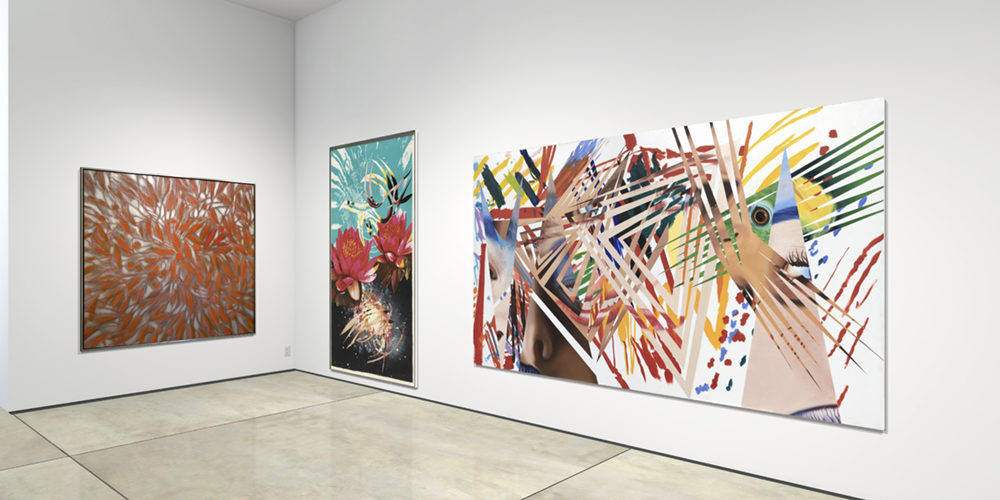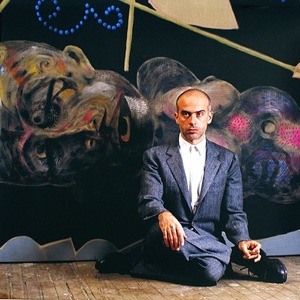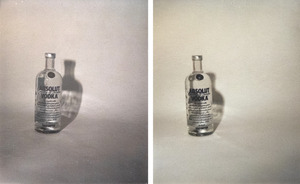It Was Acceptable in the 80s
About
The ‘80s has been a cultural touchstone for decades influencing fashion, film, and television, but its influence as a nexus of art has mostly been a blind spot. But take a step back and the full force of the decade becomes apparent, and placed into a socio-political context, we can see a mix of action and reaction to previous movements.
The exhibition takes a broad look at a decade of rapid change and reactionism. It seeks to place in context and in juxtaposition a host of movements and groups of artists to better understand the art and artists, the relationships they formed, and to understand the groundwork they laid for future generations. In this vein, the show focuses on artists that came up or worked in the 1980s while also looking ahead at some of the work they would go on to produce.
One of the most important groups to emerge were the Neo-Expressionists, which included Julian Schnabel, Francesco Clemente, Mimmo Paladino, and Sandro Chia. Despite disparate geographical location, what united the artists were the use of excessive mixed media, self-consciously gestural brushwork, and crude figuration, aligned in a push back against the previous decade’s reliance on minimalism and conceptualism. High concept gave way to high-impact works, focused less on ideas and more on the surface. Underlying this “return” to painting was a brash bravado and machismo, mirroring the conservatism of the decade. Compare them with the artists of the Pattern and Decoration in our virtual exhibition, “Pattern and Decoration: Feminism and Friendship”, and one can see a conscious return to the mythos of “heroic” art and singular “genius”.
But neither conceptualism nor collaboration ended. Emerging in the ‘70s and into the ‘80s, the Pictures Generation redefined what imagery could be used in art and how it could be used. A loose association including Cindy Sherman and Richard Prince, like the Neo-Expressionists, emerged from a more disillusioned America, reeling from Watergate, the end of the Vietnam War, and stagflation of the ‘70s. Rather than turn to excessive bravado, the Pictures Generation turned to newly emerged critical theory such as deconstruction pioneered by French writers including Michel Foucault. Using mass media, Sherman, Prince, and their fellow artists quoted, excavated, reframed, rethought, and restaged “pictures” and photography to question authenticity versus originality and how they shape our perceptions of ourselves and the world. Essentialist identity gave way to conceptualizing social constructions.
The work produced is at once seductive and coolly detached. “Untitled No. 110” recalls Sherman’s earlier celebrated series, Untitled Film Stills. Sherman’s work deals with the role and constructed identities of women. On the flipside, Prince appropriates words and images, asking us to consider what these images mean to collective culture while questioning authenticity.
It wasn’t just newer or emerging artists that conquered the decade. Despite his name being synonymous with Pop Art of midcentury America, Andy Warhol reached a new level of fame and celebrity during this decade. More than ever, Warhol turned his eye to the rich, famous, and infamous shining a light on what it means to be American and what is American culture. His fellow Pop Artist, James Rosenquist, even had one of his paintings, “Samba School”, featured in a defining movie of the period – “Wall Street”. As the movie points out of American culture of the era, “… greed, for lack of a better word, is good.” This material exuberance is not unconnected with the emergence of the Neo-Expressionists.
Money touched other parts of the time. Known as the “Designer Decade” the prevailing trend was Postmodernism. Surfaces and appearance took precedence over functionality, and consumer desire was subverted while retaining commercial appeal. This trend to theatricality and gloss shifted away from subversion and irony when it joined the surge of consumerism and corporation interest. At this intersection, artists like Jeff Koons rose to fame. Koons elevates everyday objects that undermine our expectations while also emphasizing their own kitschy nature. The works in the exhibition recall Faberge eggs filtered through a glossy and tacky filter. Is it a cheap imitation? Is it a continuation of craft and art history? Is Koons interrogating consumerism, celebrating it, or something in between?
Cartoon-like and slightly monstrous, George Condo’s portraits are a wonderful expression of post-modern art and thinking. As described by the V&A, “the Postmodern object reflected the desire to combine subversive statements with commercial appeal”. In this statement is the beating heart of Condo’s paintings. Condo paints from memory, and in looking at his work, the viewer can envision how these paintings are refracted and recollected images dredged up from Condo’s memory of art history and of psychological states. Everything old becomes new again.
Nevertheless, in contrast to the mythic genius of the singular artist in the Neo-Expressionist movement (and art history in general), collaboration was critically important in this period. Looking at the photography of Tseng Kwong Chi and Warhol, we see how artists held important dialogues among themselves. In the photo of Grace Jones, we see a three-way conversation among Grace Jones, Kwong Chi the photographer, and Keith Haring who painted Jones.
This exhibition closes out with the most nebulous of movements from the era. So amorphous is it that it has variously been termed Post-Conceptualism, Neo Conceptual, Neo-Geometric Conceptualism (Neo-Geo) and Post-Abstract Abstraction. Artists under this large umbrella include Jenny Holzer, Donald Sultan, Christopher Wool, Peter Halley, Ross Bleckner and more. What united these diverse artists was the idea that concept could take precedence over the final product in the extreme, and there was an air of “simulation” to them. For example, Halley’s works appear to be a continuation of minimalist works in the vein of Frank Stella. Yet, the painting is a critique of consumption and industrialism. Like Halley, Bleckner’s paintings co-opt the aesthetic of Minimalism or Op Art while making emotional and political statements, poignantly on the destruction of the AIDS crisis. Even when the paintings are more representational, painters like Sultan examined the consumption of both the image and the art object. Abstraction isn’t just abstraction. It takes on new meanings in new environments.
While Koons and Condo could be considered the most emblematic of Postmodernism, many of the other artists in Post-Conceptualism could be considered Postmodern, a sense of subversion, contradiction, and irony cloaked in theatrics and bolstered by the theoretical. Holzer’s sculpture is enticing through its use of materials, its shape, and even the words carved into the seat, but look closer and the truism confounds and disturbs. Holzer’s work subverts our consumerist impulses.
The dynamic decade proved a fertile time for art. Artists moved in different directions in loose associations in seemingly contradictory ways, and yet the dialogues amongst themselves propelled. These artists did not just break from the past but questioned what it meant for the present. It is not a coincidence that studying at the New York Studio School, founded by artist Mercedes Matter, had a profound influence on Christopher Wool. Learn more about the school and Matter in our virtual exhibition Merceds Matter: A Miraculous Quality. From Koons to Sherman to Holzer, the artists were at once looking backwards and forwards with a sense of style and irony.










